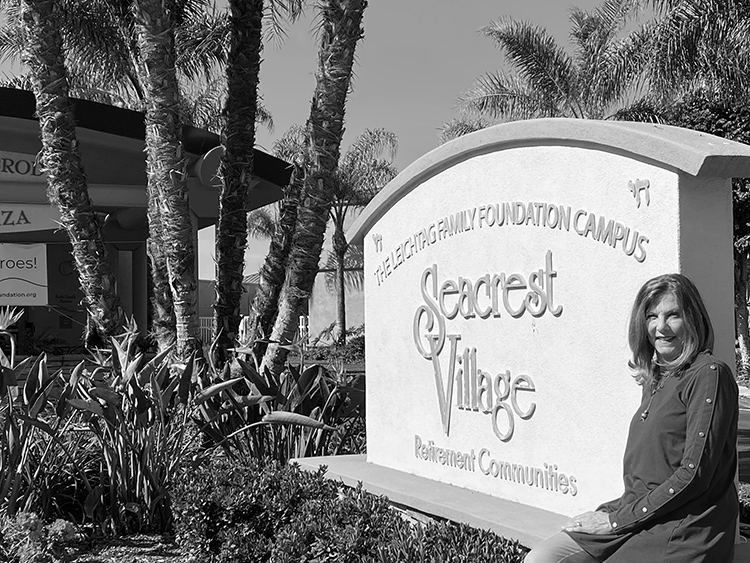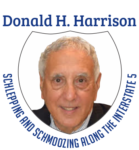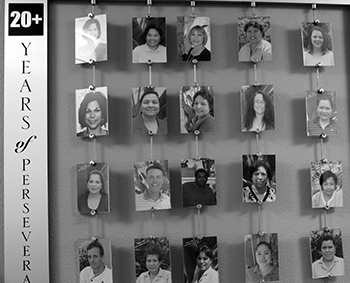 Editor’s Note: This is the 12th chapter in Volume 3 of Editor Emeritus Donald H. Harrison’s 2022 trilogy, “Schlepping and Schmoozing Along the Interstate 5.” All three books as well as others written by Harrison may be purchased from Amazon.com.
Editor’s Note: This is the 12th chapter in Volume 3 of Editor Emeritus Donald H. Harrison’s 2022 trilogy, “Schlepping and Schmoozing Along the Interstate 5.” All three books as well as others written by Harrison may be purchased from Amazon.com.
Schlepping and Schmoozing Along the Interstate 5, Volume 3, Exit 41B (Encinitas Boulevard): Seacrest Village
From the northbound Interstate 5, take the Encinitas Boulevard exit, turn right, and then make a quick left onto Saxony Road. Seacrest Village will be on the right at 211 Saxony Road.

 In April 2022, Pam Ferris was elected as the board chair of the national Association of Jewish Aging Services in testament to her service to the San Diego Hebrew Home since 1989, and her role since 2000 as the President and CEO of Seacrest Village Retirement Communities, also known as San Diego Hebrew Homes.
In April 2022, Pam Ferris was elected as the board chair of the national Association of Jewish Aging Services in testament to her service to the San Diego Hebrew Home since 1989, and her role since 2000 as the President and CEO of Seacrest Village Retirement Communities, also known as San Diego Hebrew Homes.
The Association brings together the executives of more than 80 Jewish homes across North America who share best practices and analyze trends within the industry.
One might say that Ferris was destined for this line of work. Her maternal uncle, Gershom Cohn, was the owner of Lincoln Manor, a nursing home in Decatur, Illinois, where Ferris grew up as part of the city’s small but vibrant Jewish community. Her father, Irving “Buddy” Melnik and another uncle were investors in the nursing home. While still in high school, Ferris was hired to help run activities at Lincoln Manor, including “bingo, bringing people in for discussion groups, fitness programs, music programs, and card games.”
During an April 2022 interview, Ferris recalled approaching the manor’s administrator, a woman named Shelba, and saying, “We both know that I got this job because my family is involved here. I just want to let you know that if ever you think I am not doing a good job, please feel free to fire me.”
She explained that she felt it important then to retain the job because of her merits, not because of her connections. She didn’t want anyone to think that she felt entitled, nor did she “want the people I worked with to feel like I was only there because I was the owner’s niece.”
That sensitivity to people’s feelings and opinions would show up again and again in Ferris’ career in gerontology. After her parents divorced, Ferris followed her mother, Francy Melnik, to La Jolla, which had been recommended to her by longtime friends from Decatur, Teedy and Irving Appelbaum, whose daughter Marcia lived in La Jolla. Several years later, the Appelbaums retired to La Jolla, and once again, the friends were united.
Ferris, who already had a bachelor’s degree in recreational therapy from Southern Illinois University, decided to obtain a master’s degree in social work from San Diego State University, where she met her future husband, Walter. As part of SDSU’s program, she interned at the San Diego Hebrew Home for the Aged, which was located on 54th Street on a slight hill overlooking the Jewish Community Center. She came under the wing of the Hebrew Homes’ executive director, Michael Ellentuck, who suggested that she become certified by the State of California in the field of nursing home administration. “You needed 1,600 hours of training and you had to go through all the different departments,” Ferris related. Ellentuck told her that she could complete work for her MSW and for the administrator’s license concurrently and that he would help her.
“So, he put me on this program, and I started to work with all the different departments: housekeeping, maintenance, culinary, social services, rehabilitation, therapy, nursing. You work with people in each department to find out what they do.” After completing both courses of study in 1983, Ferris was hired as an assistant administrator at Alvarado Convalescent Hospital – a position she retained for five years.
She was about to accept a position as the administrator of a small nursing home in Lemon Grove when Ellentuck invited her to meet with him in Encinitas where Seacrest Village was under construction. He told here that he would be focusing on the development of Seacrest Village and needed to have someone at 54th Street administering the nursing home where only seven years before she had interned.
After accepting the job, “it was like going home,” Ferris recalled. “They all remembered me because they had trained me. I had gone through all the departments there and it was very comfortable to go back, even though it was my first time as an administrator by myself, not as an assistant.”
It was an exciting time. She and Walter had their first child, Kate, who was approximately eight months old when Pam returned to 54th Street. They later had a son, Drew, today a real estate agent. Drew had the exciting experience of playing in the pre-seasons in the National Football League, trying out as a long-snapper for the Tampa Bay Buccaneers and the Seattle Seahawks, but not receiving a regular season contract. Pam’s husband, Walter, had a master’s in social work with a concentration in the field of mental health. “He does psychotherapy today for a company called Coherence Associates,” she informed me.
In sharing one of the challenges that she and her staff faces, Ferris explained that over time, “residents become more frail and they need a higher level of care and we have to try to articulate that to the families who don’t always see the things that the staff is seeing. Often, they don’t want to see it, and that is understandable because it is their loved one. Because we are with the residents 24/7, we see their needs as they change.”
“Dementia is still a huge stigma in our society, and it is one of the things that is hardest for families to deal with,” Ferris continued. “What happens is that they acquiesce over time because they begin to understand and accept. Later they may say, ‘You were so right, we should have listened; we should have moved her sooner’ and we understand completely. I wish that our society in general was just a little bit more understanding, and not so stigmatized when it comes to Alzheimer’s, dementia, and other mental health issues.”
After a year and a half at 54th Street, Ferris was invited again to Ellentuck’s office. This time, he wanted Ferris to open and administer the nursing home at Seacrest Village. It was not an easy decision for her, Ferris said. She and her husband were living in the San Carlos neighborhood of San Diego, where their daughter Kate was attending preschool at Tifereth Israel Synagogue. From her home, Ferris could commute to the 54th Street Hebrew Home without ever having to use the freeway. “I had just a year and a half to get 54thStret under my belt and now I am going to start another new job?” Although she accepted the job, it took her nine years of commuting before the family left San Carlos and purchased a home four miles from Seacrest Village – four miles which Ferris occasionally walks to and from work “to clear my head.”
Her decision to move to Seacrest partially was prompted by the fact that her 95-year-old grandmother, Ida Cohn, had decided to move from her retirement home in Florida to Seacrest Village. When Ferris went to the meeting with Ellentuck, “I had sort of decided I would take the position.” While Pam was at Seacrest that day, Grandmother Ida came up to her and said, “You know there is an administrator position open here. Some of my friends and I were wondering if you could come here and be the administrator.” Ferris had just consented to the new job, but “I couldn’t tell her because it wasn’t announced yet.”
Her grandmother “lived here (at Seacrest) for seven years and passed away at the age of 102,” Ferris told me. “We had a mutual admiration club because I would see her in the hallway and she would say, ‘I am so proud of you’ and I would see her and say, ‘I am so proud of you,’ and it was really wonderful to have her here.”
Ferris said she made a point of having friendly, loving interactions not only with her grandmother but with all the residents. She said that there is a “joy of serving and working with older adults. They have lived before us; they have all this rich history. They are wiser; they have all this experience that you haven’t had. If you are smart, you will listen and learn from them.”
In sharing stories about her staff, Ferris related a controversy she had to handle after a resident objected to the hiring of a young chef from Germany. The woman, who had been able to leave Europe before World War II, identified herself as a Holocaust survivor. When she met the German chef, she asked him bluntly, “Why did you kill all my people?”
Ferris said that she and the young man, who was probably no more than 30 years old, were appalled by the question. “I felt she owed him an apology.” Together, along with the director of the culinary department, they went to the woman’s apartment. The woman said she could not apologize because she was so upset. Then, according to Ferris, “the chef said to her that he was sorry, that he wasn’t even born yet when the Holocaust occurred, and that he and his people are very, very sorry. It was a very poignant moment that this young man apologized to her, and she couldn’t apologize to him.”
Over the years, Seacrest Village has been home to numerous Holocaust survivors, Ferris said. “We don’t have too many anymore, sadly, because that generation has all but passed. I think that is probably one of the greatest honors I’ve had, caring for the survivors.”
The staff of Seacrest Village, numbering about 300 people in April 2022, are intensively trained and educated about the Holocaust, Ferris said.
She said an important aspect of a senior residence is the necessity to hire people who enjoy being with older adults. “I tell everybody that you may love it, or you may not love it. If you don’t love it, I know that this is weird to hear on your first day but do yourself a favor and hand in your resignation. So it professionally, but you deserve to be in a job that you really love.”

The staff—many of them with years of service at Seacrest Village, as attested to by plaques on a wall celebrating Seacrest employees—often stay in the job despite what others might consider more attractive job opportunities.
“If you think about it,” said Ferris, “we have housekeepers, we have maintenance staff, we have chefs, nurses, security guards, admissions, marketing, accounting, administration, culinary, human resources, and so many more dedicated employees and they choose this environment of senior care because they want to be with the residents. It works because they really want to be here.”
Among all the employees, Joyce Lundin in 2022 had the longest tenure –53 years. Lundin worked at the 54th Street Hebrew Home “when I walked in as a young intern,” Ferris said. ‘She was a caregiver on the PM shift.” Lundin asked to be transferred to the nursing home at Seacrest Village prior to Ferris’s own transfer there. “Oh, did I benefit because when I got here, there was a 20-year-employee to help us open the nursing home!” Lundin’s employment anniversary is celebrated every year as ‘Joyce Lundin Day.”
Given that Seacrest Village is located in the affluent city of Encinitas, not all employees can afford to live close by. With gas prices having risen to over $6 a gallon in March and April 2022, some staff members endured this with commutes from San Marcos, Oceanside, and Vista, while others had more expensive commutes from Murietta and Temecula as well as from Tijuana, Mexico.
“If we take care of our employees and show them that we care, do nice things for them, and help them have a good work-life balance and show our gratitude, they will, in turn, take care of the residents,” Ferris said. “They will know that the work that they do every day is so important and that they are changing lives every day. They go home and they are exhausted, and I know that because I am too, but if you just think about it, the interaction that they had with one resident in the hallway could have changed that resident’s whole day. Our directors and executive team, we all try to do that, and it is very important.”

Ferris noted that Seacrest Village installed two commissioned “heart of gold” sculptures on its grounds in April 2022. A plaque near one of them reads: “This heart of gold serves as a reminder of the love and the compassion that insured the safety and wellbeing of our Seacrest seniors and staff during the COVID-19 pandemic. We made our way through this most difficult time as one Seacrest family. Together we will go into the future but remembering those whom we lost and grateful for our commitment to one another.”
Unfortunately, the COVID-19 pandemic made it more difficult for Seacrest to attract new employees in higher paying fields, nurses for example. To attract more employees, pay scales were being “significantly” increased at Seacrest Village, leading to higher rates that residents must pay. Yet there still were staff shortages. “Every other retirement community in San Diego has felt the need to raise their rates.”
“We cant bring any new residents into the nursing home right now because we don’t have enough nurses to take care of them, so that is on hold right now,” Ferris lamented. “People want to work per diem; they don’t want to work full time or part time. When you work per diem, we could call you and ask you to do a shift, and you can say, ‘No I am busy, I can’t do it’ and that is that. It is definitely a challenge.”
“The work forced today has changed unbelievably since COVID-19,” Ferris continued. “One of the things that COVID-19 has done is make people reevaluate their lives, looking at their work-life balance and they realize it is probably off. Employers are really having a hard time. We have caregivers who love working for Seacrest-at-Home. We don’t have enough of them, however, so when people call to start the service, we have to put them on a waiting list. It is really frustrating to want to serve our community, as we have or almost 80 years, and not to be able to do more when the people need it the most. Now people are living longer and there are a lot more of them out there. The work is there, and the need is there, but we don’t have the staff to provide it. It is very frustrating and sad.”
Architects considered the frailties of residents when they designed Seacrest Village, Ferris said proudly. Residents don’t have to bend down to reach wall sockets for their electrical devices, for example. Neither do they have to step over the lips of a shower stall, risking a fall. “The bathrooms are huge, and you can wheel a wheelchair right in,” Ferris said. “We wanted those bathrooms to be as safe as possible and they are.”
Becoming a resident of Seacrest Village is an expensive proposition, Ferris admits. “If people are lucky, they have sold their homes at the top of the market and they have the equity in their homes to be able to pay for life in the senior community. Some people have long-care insurance. Some people are on Medi-Cal and we have many people here who are on scholarship. We spend $2.5 million a year, taking care of our people.”
That money is raised by the Seacrest Foundation, whose chief officer, Robin Israel, started in 1989, the same year as Ferris. Another longtime executive is Bradley Blose, the chief operating officer who in 2022 had been at Seacrest Village for 27 years. “The tenure of our executive team speaks to the love and dedication for the work we do,” Ferris states.
In our interview, Ferris outlined some recent and prospective changes in the way the home operates For example, for some years now, Seacrest Village has been accepting applications from non-Jews who are happy to live in a Jewish environment.

She said those who are not of the Jewish faith are attracted to Seacrest because “they know we offer the best care. The care is good, the supplies are there for the staff, and the staffing levels are good, albeit being a difficult time to attract new staff. There are some operators who might bring in more residents even if they don’t have adequate staff to serve them. We won’t do that.”
Another change; Rabbi Leah Her retired after Passover 2022 and Seacrest engaged Cantor Kathy Robbins and others to lead services and programs.
While Seacrest Village will always remain a kosher facility, it has decided to take advantage of vegan “cheese” for use in its Cobb salads (with chicken) and on top of hamburgers. “We also have the Beyond Burger too,” Ferris said. “We want to be able to offer a variety within the confines of kashrut. I’ve always respected that we are kosher, even though maybe 2 percent of the residents keep kosher. It is just a way to stay inclusive. Every Jewish home in the country is struggling with this issue. Some of the new Jewish homes that have been built have separate dining rooms, so they give the option. It is an expensive proposition to maintain kashrut but that has never been an issue for our board.”
Ferris is only the fourth person to serve as the CEO of Seacrest Village in its 80-year history. ‘I have immense gratitude for our wonderful Jewish community who, since 1944—when a small house serving 10 residents opened on 4th Avenue in San Diego—have supported having a home where older adults can live with dignity, outstanding care, quality, and service. They say ‘it takes a village’ and I will be forever grateful for our founder, Victor Shulman, as well as the Jolly 16 (an early 20th-century group of women who raised funds), Ted Rosen, Ike Sway, and Michael Ellentuck (predecessors as CEOs) and the many others in our community who had the foresight to create and expand such a place.”
She added: “I am honored to have a career where I work with incredible heroes who share my passion for serving older adults, and to have the support of remarkable lay leaders, contributors, volunteers, family members, and residents—all of whom understand the importance of the Commandment ‘Honor Thy Father and Thy Mother.’”
*
Donald H. Harrison is editor emeritus of San Diego Jewish World. He may be contacted via donald.harrison@sdjewishworld.com